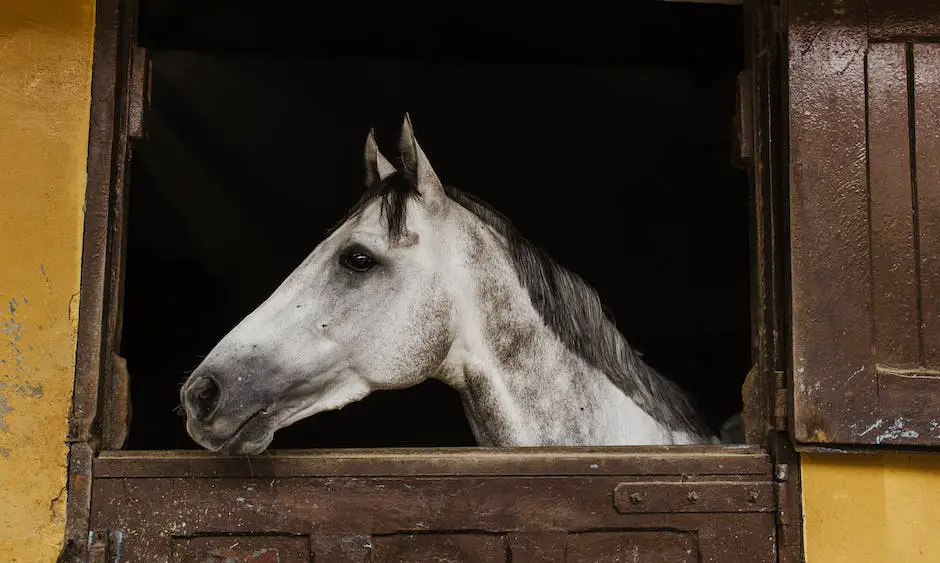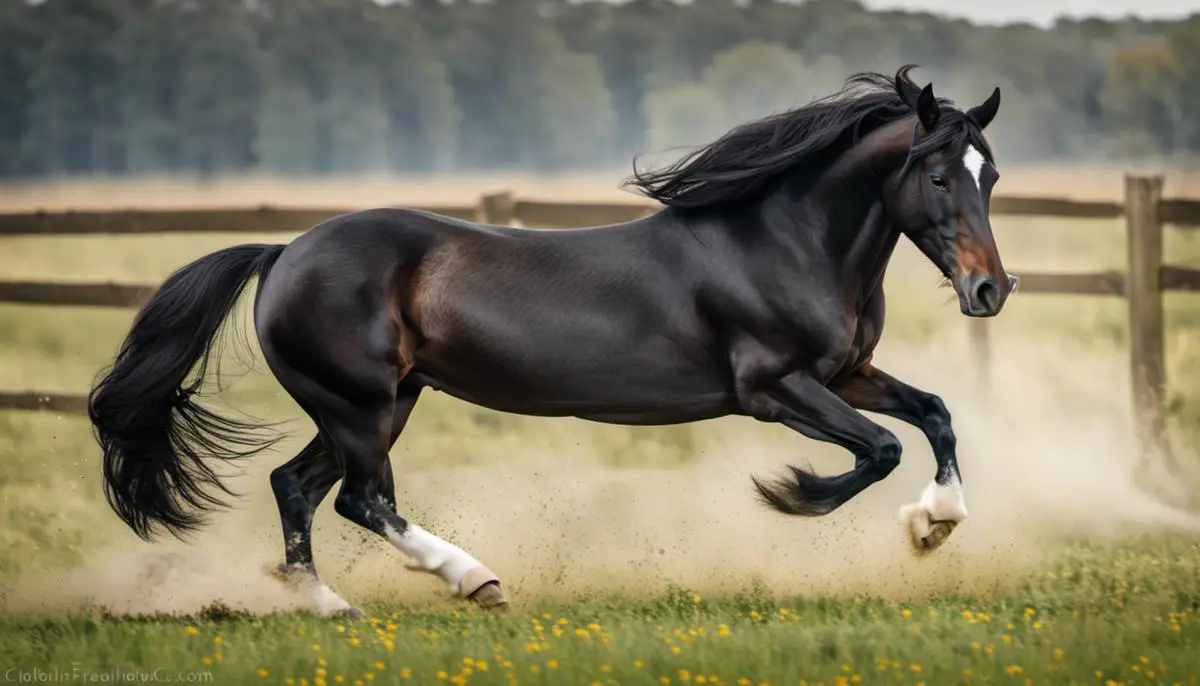The prodigious world of horses harbors a splendid array of breeds, each with distinct characteristics and fascinating histories. One such breed that has carved a niche for itself is the East Friesian Horse. Originating from Lower Saxony in East Frisia, this breed is steeped in history that intertwines with the evolution of horse breeding. Known for its robust format, balanced temperament and diverse adaptability, the East Friesian embodies a confluence of strength, grace, and resilience. This essay seeks to shine a spotlight on this remarkable breed, exploring its historical lineage, distinctive characteristics, and modern-day uses.
Table of Contents (Horspedia)
Historical Background of East Friesian Horses
The East Friesian Horse
The East Friesian horse, also known as Ostfriesen and Alt-Oldenburger, has deep roots in East Frisia, a coastal region in Germany. These heavy warmbloods, known for their strength and durability, were initially developed to meet agricultural needs and provide transportation within the region.
Evolution of the Breed
As early as the 1300s, the East Friesian breed was recognized for its distinct characteristics. The breed was developed mostly by selection from the old Black Friesians but with considerable in-breeding. The breed evolved significantly over time to meet changing local needs and international preferences. During the 18th century, when horse-drawn artillery became central to warfare, the breed was further refined to increase its durability and strength. This period saw the East Friesian become somewhat heavier and more powerful, in line with the demand for sturdy war horses.
Breeding Influence
Selective breeding practices over the years influenced the East Friesian horse’s physical traits. Breeds such as Andalusian and Neapolitan horses were reportedly crossed with East Friesians to refine its appearance and make it more suitable for riding, carriage driving, and parade use. This resulted in the East Friesian horse’s characteristic strength, stamina, and stunning appearance, with its generally black coat, arched neck, and strong, muscular body.
Influence on Other Breeds
The East Friesian horse has significantly influenced other horse breeds. It has played a significant role in developing the Groningen horse, another heavy warmblood breed from the Netherlands. Additionally, East Friesian mares have been used extensively to improve several German breeds, including the Oldenburg.
Famous East Friesian Horses
Throughout history, East Friesian horses have often come into the limelight for their athleticism and stunning looks. Warmonda, a famous mare from this breed, became a superior broodmare in the 20th century. Her progeny not only included successful show jumpers and hunting horses, but several became profoundly influential breeding stallions, contributing to the propagation of the breed across Europe.
East Friesian Horses in the Modern World
In today’s world, East Friesian horses continue to be of great importance due to their flexibility in performing various tasks. Not only are they employed for heavy drafting work, but they’re also favored in the field of sport horse disciplines. Coupled with their striking aesthetics and remarkable ability to be trained, these horses excel in parades and official ceremonies too.

Physical Characteristics and Temperament
Identifying Features of East Friesian Horses
The Friesian Horse, also referred to as East Friesian, hails from Friesland in the Netherlands. These horses are distinguished by a set of unique physical characteristics that make them a sight to behold. Most Friesians sport a glossy black coat, although a minor proportion may be chestnut. Other colors, however, are often viewed as fallouts from the breed’s standard.
Friesians possess a stately and desirable stature, with their long, flowing manes and tails further enhancing their enchanting appeal. These horses stand 15 to 17 hands tall on average, with the males being slightly more towering than their female counterparts. Physically, they exhibit a solid, muscular frame, a neatly-defined Spanish-style head held high, and wide, expressive eyes. Their legs, though relatively short, are robust, topped with magnificent feathers that cover large, round hooves.
Health Issues and Life Expectancy
In terms of health, Friesians are generally hearty but they are unfortunately predisposed to several serious health problems due to their inbreeding to maintain pure bloodlines. These health issues include aortic rupture, dwarfism, and a skin condition called megaesophagus. Also, some horses can suffer from a genetic disorder known as Hydrocephalus, where there is a buildup of cerebrospinal fluid in the brain, causing the head to enlarge.
The life expectancy of East Friesian horses is generally between 15 to 20 years, which can be affected by several factors, including diet, exercise, and veterinary care. Despite some of the associated health concerns, with regular vet check-ups and proper care, most Friesians live healthy, hearty lives.
An Insight into the Temperament of East Friesian Horses
East Friesian Horses are renowned for their temperament. They are gentle and calm by nature with a noticeable level of intelligence. It’s common for them to develop strong bonds with people, displaying an eagerness to please and work which makes them highly trainable.
However, their zealousness to impress might sometimes lead to overexertion. Hence, it’s crucial for their handlers to stay alert to their fatigue and refrain from exploiting their willingness. East Friesians, like most horse breeds, can prospectively display traits of stubbornness, underscoring the importance of consistent training.
Historically, Friesians have been involved in numerous roles from strenuous farm labor to medieval warfare. In contemporary times, they are primarily employed in dressage, recreational riding, and even entertain as movie stars. Their ability to adapt combined with their calm temperament has sustained their popularity over decades. The mesmerizing aesthetics and distinctive features of the breed continue to enthrall horse lovers across the globe.

The Uses of East Friesian Horses Today
Modern Adaptability and Versatility of East Friesian Horses
The East Friesian Horse, though primarily recognized for their contribution to dairy farming, has carved a unique place for itself beyond agrarian practices. Nowadays, this robust breed is known for its versatility across diverse roles including but not limited to equestrian sports, farming, and recreational riding.
In the realm of equestrian sports, East Friesians have carved a niche for themselves particularly in activities necessitating strength and endurance. Their agility, balance, and inherent power are displayed splendidly in dressage, recreational driving, and carriage driving competitions.
With respect to farming, while modern mechanization has reduced the reliance on draft horses, the East Friesian horse still holds value in many smaller or organic farms. The breed’s minimal environmental impact combined with their remarkable strength makes them a useful utility in these settings.
East Friesian Horse: Pleasure Riding and Beyond
Pleasure riding is another area where the East Friesian Horse has been deployed with increasing frequency. This is primarily due to their gentle and calm temperament, making them suitable for riders of all ages and skill levels. Despite their size and strength, they are known to be docile, responsive, and cooperative, perfect traits for a companion horse.
They are also commonly used for therapeutic riding owing to their smooth and rhythmic gaits, which can provide physical, cognitive, and emotional benefits to riders with disabilities.
Organizations Dedicated to East Friesian Horse
In recognition of the importance of the East Friesian Horse, there are several organizations and societies dedicated to their preservation, enhancement, and awareness. These include the East Friesian Horse Society of America (EFHSA) which holds competitions, regulatory functions, and services to promote and protect the breed. EFHSA’s activities also involve upholding the integrity of the breed registry, ensuring the welfare of the animals, and fostering community among East Friesian Horse enthusiasts.
The versatility of the East Friesian Horse is a testament to its adaptability
Despite their initial main role as a dairy breed, they have found their way into many vital areas of human life, from sports and farming to therapy and leisure. With the sustained interest and dedication of enthusiasts and dedicated organizations, the future seems promising for these powerful yet gentle horses.

As we explore the diverse sphere of equestrian, the East Friesian breed has undeniably etched its mark. Its captivating history represents a significant part of our equine heritage. Furthermore, the breed’s distinctive physical features and balanced temperament make it undeniably unique and preferred for a multitude of disciplines today. Despite the challenges and health issues that they may wrestle with, east Friesians continue to thrive, propelled by their adaptability, versatility, and the dedicated efforts of organizations and individuals committed to their preservation. Ultimately, the East Friesian horse is not simply a breed; it’s a testament to the beauty of evolution and an embodiment of our connection with the natural world.

